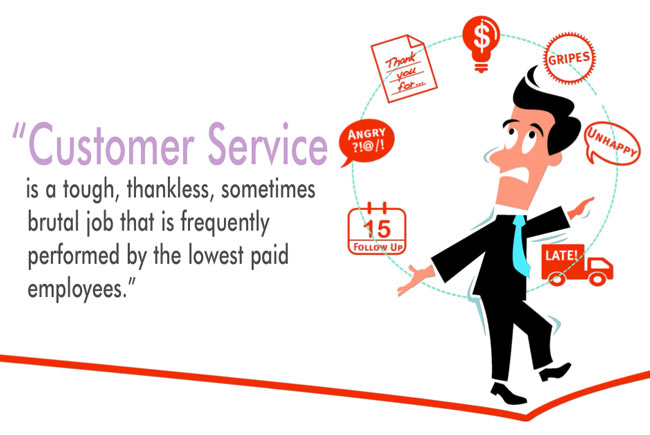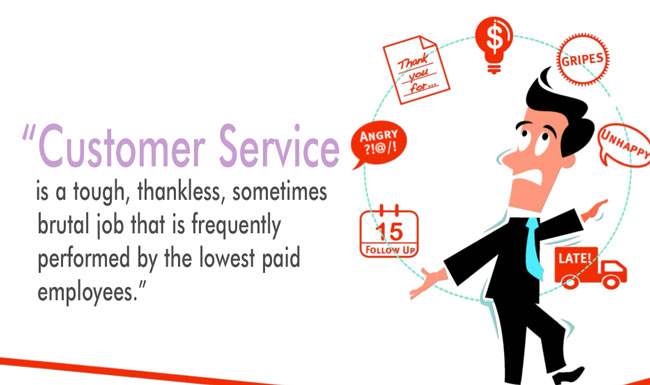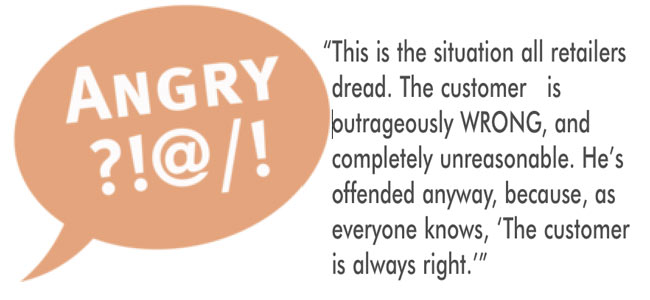We hear the term “customer service” a lot, but what is it, and why is it so important, especially for home furnishings and especially mattress retailers?
Before I started working on this article, I looked up the term “customer service” in both my Webster’s and the big 24 volume Oxford English Dictionary, and oddly, especially for such a fundamental commercial function in our Western consumer culture, the term did not appear in either publication. This was surprising to me, given the vast, almost inexhaustible comprehensiveness of the mighty O.E.D.
We all think we know what is meant by the term “customer service,” but before delving into specific customer service issues it will be useful to define the term.

Customer vs. Prospective Customer
What is the definition of a “customer?” sounds like a ridiculous question, but it is important to distinguish “customer” from “prospective customer.” They are not the same thing. A customer is someone who has actually purchased something. A prospective customer only becomes a customer after he buys, not before. Until then, he is the responsibility of the Sales Department. Therefore, customer service, at least in the context of this article, can be defined as a set of policies and actions that respond to a customer’s (buyer’s) after-the-sale enquiries or complaints. Note that I said “policies.” So, often, customer service is just a knee-jerk reaction to an irate customer’s ravings. Everybody, customer included, is happier if a retailer has a policy, in print, on how to handle customer post-sale communications, good and bad.
Is The Customer Always Right?
The famous phrase, “The Customer is Always Right,” is believed to have been first uttered in 1909 by Harry Gordon Selfridge, a famous London department store owner.
Is the customer always right? Yes, and no. What Mr. Selfridge meant when he said that, if I may interpret his meaning, is that the customer is entitled to the benefit of the doubt with any complaint. Customer complaints fall into three general categories:
- The seller made an obvious error, the customer is offended by it, and the retailer has an obligation to remedy the situation enthusiastically and apologetically admitting error with no questions asked.
- The seller may have made an error, or maybe not; there is some ambiguity as to where the blame lies. The customer is offended, either way. In this situation, the seller once again assumes the culpability, fixes the problem, and satisfies the customer, no questions asked. In other words, the customer gets the benefit of the doubt.
- This is the situation all retailers dread, the one for which it is so difficult to establish a clear-cut, fair policy where everyone exits happily. It is when the customer is outrageously WRONG, and completely unreasonable. He’s offended anyway, because, as everyone knows, “The customer is always right.” But, what does the retailer do about it? Fortunately, I am retired from retail and no longer have to deal with these types, and I have very little advice on how to handle them. The only thing I can say is to try to minimize the damage as best you can.
Goals Of Customer Service
The goals of customer service are pretty simple. The main theme is “keep the customer happy,” so she will keep coming back. First, get off to a good start. Deliver the customer’s merchandise, in good condition, as quickly as possible. I cannot stress this point strongly enough. Deliver the same day, if possible. The quicker the customer gets his stuff, the happier he will be. Will great service reward you with a loyal customer? Not necessarily. Customers are notoriously fickle. Bad service, however, will probably lose you one, forever.
The Phases Of Customer Service
By phases, we mean the time and situation of various customer service functions. These phases break down as follows:
- After-the-sale but pre-delivery.
- The actual delivery, (or, customer pick up).
- After-the-delivery – the merchandise is in the customer’s house.
Each of these phases has its own unique preparation and policies.

Post Sale Pre-Delivery Customer Service
Since mattresses are usually delivered within a day or two of the sale, customer service (in this phase) is mostly just making the call announcing that the merchandise is on the way. With furniture, however, this phase is often all too long and perilous. The customer has the right, in many states, to cancel the sale anytime before delivery and legally demand and receive a full refund of the purchase price.
Management hates it when this happens. Therefore, the RSA who made the sale must keep the customer up-to-date on his purchase. Many furniture purchases that are not stocked can take six weeks or more between sale and delivery. This can be a very tense interval for both customer and store. The customer is anxious for his beautiful new merchandise, and the store doesn’t want the sale to cancel. There are four things you can say and do to avoid problems.
- Do not create unreasonable expectations at the get-go. Before the sale is completed and the money collected, make certain that the customer understands that non-stock merchandise has to be ordered. Then, if it normally takes six weeks to arrive, tell the customer that it can take up to eight weeks. Give yourself some leeway. If it comes in within six weeks, you look great. If you say six to eight weeks, the customer hears “six weeks.” If you say four to six weeks, he hears “four weeks.” Do yourself a favor.
- Follow up. Stay on top of the order department and the manufacturer to make sure everything is on schedule. Don’t be the last to find out that your customer’s SKU has been discontinued or is behind schedule.
- Keep your customer informed. Don’t let him sit at home and stew for six weeks, and then tell him that the factory had a glitch and now it will be four more weeks before he begins to enjoy his great new product. It is wise to call every week to give him an update. Call even if you don’t have anything new to report. The customer will appreciate your diligence.
- 4.Don’t do this! Don’t throw the money and ticket in the drawer and forget the sale ever happened. Then, suddenly six weeks later you get an annoyed call from an impatient customer, and you cannot even remember who he is, or what you sold him.
Disposition (Delivery Or Pick-Up)
Since this is the Better Bedding Sales series, we will talk about disposition of mattress sets. Urgency is the hallmark of mattress selling. This means that many mattress sales are either delivered or picked up the same day as the purchase. If the customer is “taking it with him” or having same day delivery, the RSA must make absolutely sure that the merchandise is in stock. Here’s how to make sure. First, check your inventory list. If there are several listed as available and you have confidence in the list, you may be okay. If, however, the inventory sheet shows only one (1) available, you should double check that number. Either call the warehouse or go lay your hands on it yourself. Even after you lay hands on the merchandise, go to the Sold-But-Undelivered file. Make sure that it has not been previously sold and is waiting for delivery. Never promise a delivery until you have done this check first.
We will only mention a few ideas about delivery. Here is a short list.
- Your vehicle. Deliver merchandise in a vehicle that will not embarrass the store. Identify your delivery vehicle with some kind of label. If two rough looking characters pull up to a customer’s house in a beat-up truck with no identifiers, the customer might not answer the door.
- Scary employees. Beware of delivery employees who will frighten little old ladies. Or, if that’s not possible, have them wear a company shirt or uniform that will clearly identify who they are.
- Bed inspection. Check and double check all merchandise before loading the delivery vehicle. Don’t let damaged or soiled merchandise get all the way to the customer’s bedroom.
- Calling ahead. Call the customer the day before and then again the day of delivery so the customer remembers you are on the way.
- Check inside first. Require that delivery men learn the route through the house before bringing in the merchandise. Then, maybe they will observe and avoid any obstacles in the way. Strictly enforce this rule unless you enjoy a call from the customer saying that your guys knocked a prized picture off the wall or demolished a treasured porcelain ewer on an antique stand in a narrow hallway.
- Using the plumbing. Enforce with pain, if necessary, the policy that Delivery Staff NEVER ask to use the customer’s plumbing facilities, except possibly to wash their hands. Hand washing may be permissible, even advised, in the following situation. Sometimes, exquisite white ticking is sheathed within soiled plastic bags. This perfect mattress has to be removed from the bags. Only very clean hands should do this. Or, have them handle soiled bags with heavy gauge plastic gloves and then use white, clean gloves to handle the new mattress. The point being: don’t soil the new mattress!
- Carry-offs. When disposing of the customer’s old set, how do you separate that nasty carry-off from the pristine new bed? Take some extra bags to bag or even double bag the disgusting old set, so it cannot touch the new merchandise. Plastic gloves, again, are highly recommended.
Post Sale, Post Delivery Customer Service
This is where the proverbial “rubber meets the road.” This is Customer Service as most retailers understand it. How many after-the-sale calls do you get thanking you for the great service and deal? Any? No, they are almost always complainers.
If the retailer or manufacturer is clearly wrong, they are easy to handle, right? What we will discuss are those cases where the customer may be wrong, but still has an understandable gripe (the “benefit of the doubt.”) And, after that, we’ll share a few moments where you wish you had gone into any business but retail.

Benefit Of The Doubt Situations
Most customer complaints are bogus. Mattress complaints are almost always either “comfort” issues or “body impressions.” If you could get rid of these two, this business would get a lot better.
Body Impressions: What is described as a “canyon” by your customer usually turns out to be a mere half inch depression when measured professionally. How do you eliminate complaints about body impressions? A better job on the sales floor will certainly minimize them. Educate the customer on these issues. Their bed WILL get minor body impressions. Tell them that. Don’t let them discover it when making the bed.
Comfort Issues: A lot of stores offer “comfort exchanges.” I personally don’t like comfort exchanges. A lot of comfort issues result from a poor sales presentation. Any store that offers comfort exchanges, however, is well advised to publish, in writing, a very clear policy on the rules and regulations and make them known to the customer.
So, when do you fight and when should you give in to the customer? Taking back a mattress in good condition isn’t that painful. These “take back” sets, in many states, can be legally treated, processed and re-sold with proper disclaimers. Put them in your clearance area to attract bargain hunters.
Customers Who Are Outrageously Wrong
Sometimes you can spot them on the showroom floor, before they make your life miserable by buying something. Here is one example.
I was working the floor one day when a couple, probably in their mid-40s, came in. They didn’t look bad, but they were clearly not “one-percenters.’ I greeted them, and the man immediately began to show aggressively obnoxious characteristics (the lady was quiet.) He asked some vague question about warranty and I explained politely what mattress warranties meant and how they worked. Meanwhile, his wife walked away, to look at other mattresses. I’ll admit, I didn’t have very good control of the sales process in this case. Neither of them responded to my usual execution of the sales procedure; qualifying questions, etc.) Upon hearing my explanation, his eyes glazed over and sported a fiendish, evil-looking grin. He made one more incoherent comment, and I, again, explained, that the warranty was the policy of the manufacturer, and not the retailer. Then he shouted, “Then, I’ll sue!” (For what, I don’t know. He hadn’t bought anything.) I asked him if he was a lawyer. He paused for a moment, thinking about the question and then sputtered, “Yes, yes, I am.” I highly doubt it, since I’ve never witnessed a more un-lawyerly response. I responded politely, “You folks look around all you like.” I then turned and walked back to the desk and ignored them until they were gone. The lady never said a word the whole time, but she clearly wasn’t happy.
Did I handle this correctly? I don’t know. They probably bought a mattress somewhere, but I decided quickly that I did not want their business, period, at any price. Let somebody else deal with this nut.
Most of the time, unfortunately, you learn the hard way.
What if they sue you? I think I was sued four times in my 15 years as a store owner. In every case, I bent over backward to please the customer, but to no avail. You finally run out of patience with their unreasonable demands, you tell them you cannot help them any further, and so, they sue you. I won every law suit (always representing myself in court), even when they hired a lawyer. Why? Because the plaintiff was so outrageously wrong and some pre-trial preparation enabled me to win the day, every time.
BBB & Social Media Gripes: What about BBB (Better Business Bureau) gripes, or other Social Media slams? My suggestions are to:
• Do everything first, within reason and common sense, to satisfy the customer, and that failing...
• Answer the complaint in the same medium, giving your more reasonable side of story. This policy works if you do it right. Don’t let an unreasonable “customer” slander you without responding. With social media, I’ve found that my reasonable responses get a lot more “Likes” than the complaint. It’s not bad advertising, either. Turn a negative gripe into a positive message for the other readers.
Words From Famous Customer Service Reps
In researching this article, I decided to look up a few comments and maxims spoken by some people you’ve probably heard of. On its surface, it really is good advice. But, when did these famous people ever work retail or customer service? These quotes were found in an on-line article, entitled “40 Eye Opening Customer Service Quotes” by a Forbes Contributor named Ekaterina Walter, dated 03/04/14 at
www.forbes.com /sites/ekaternawalter/2014/03/04/40-eye-opening-customer-service. Forbes disclaims that opinions expressed by Forbes Contributors are their own. Anyway, here are a few of them followed by my admittedly irreverent comments.
Customer Service Quote: “The goal as a company is to have customer service that is not just the best but legendary.” ~ Sam Walton, founder of Wal-Mart.
My Comment: Wal-Mart service is legendary alright. The 2013 American Customer Satisfaction Index (ACSI) rated Wal-Mart the worst customer service of any retailer in America.
Customer Service Quote: “Your most unhappy customers are your greatest source of learning.” ~ Bill Gates – founder of Microsoft.
My Comment: How’s that Windows 8 working out for you? Has Microsoft learned anything from that? Meanwhile, Bill is playing bridge with Warren Buffet.
Customer Service Quote: “There are no traffic jams along the extra mile.” ~ Roger Staubach.
My Comment: What a great aphorism! Of course, this comment could apply to any endeavor, but has anybody ever seen Roger at a Customer Service desk, anywhere?
And My Favorite Customer Service Quote: “A customer is the most important visitor on our premises, he is not dependent on us. We are dependent on him. He is not an interruption in our work. He is the purpose of it. He is not an outsider in our business. He is part of it. We are not doing him a favor by serving him. He is doing us a favor by giving us an opportunity to do so.”
My Comment: These are words for the retailer to live by, without question. Who said this profound, meaningful and true statement? ~ None other than Mahatma Gandhi (according to the article). Did Ghandi work retail when he wasn’t freeing India from the British Empire? Or, did I miss something?
SUMMARY
Customer service is a tough, thankless, sometimes brutal job. It is frequently performed by the lowest paid employees. All the uplifting quotes, maxims and “atta-boys” by the economic elite (who’ve never done it) do not make the job feel any better.
Can bad Customer Service break your business? Can wonderful Customer Service make your business? Probably not, in either case. But good Customer Service is important to any intelligently run business. The question is: have the imperatives of customer service changed with the culture of the 21st century? Is Mr. Selfridge still right? Or, does it need a lot of thinking and re-thinking in this modern retail environment? I’d like to know what you think. Please send your comments to me at
dave@bedsellersmanual.com.